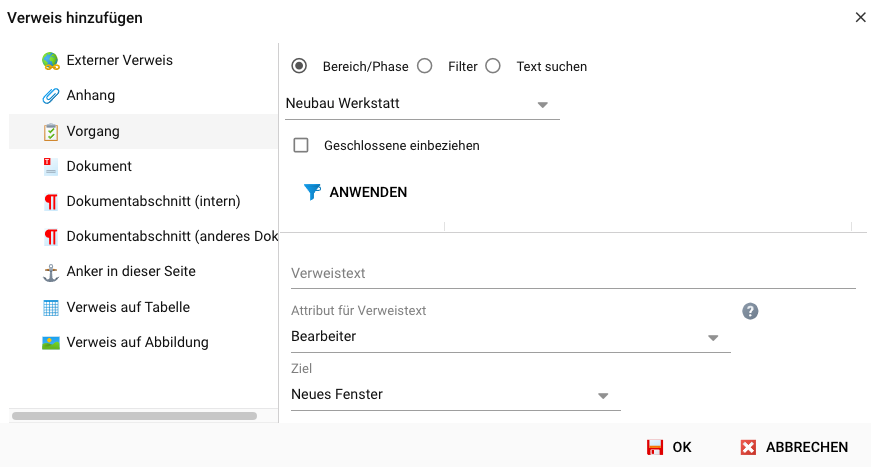Editing Content#
The wiki is not a complete replacement for a text processing program. However, it has all the necessary functions to create high-quality documents.
Editing Regular Text#
The wiki uses as much standard HTML as possible to format text. There are a few special tags that the wiki uses, for example, to embed other items (Inline Items). As with most HTML editors, it helps if you familiarize yourself with the HTML markup syntax because sometimes it is necessary to make changes to the source HTML to achieve the desired layout and appearance (button M in the toolbar).
The wiki supports images, tables, text styling such as bold, italic and underline, headings, code blocks, and ordered and unordered lists.

The wiki editor toolbar#
Adding Images and Captions#
You can drag and drop images directly into the document. Alternatively, you can also use the toolbar button G. To enlarge an image or add a caption, right-click on the image and use the appropriate options.
To create a reference to an image, the image needs a caption. You create the reference using the A button in the toolbar. For more detailed instructions on creating a reference, see the section Reference to Image.
Note
During editing, the numbers of the images are not yet shown, but only displayed in reading mode.
Adding Tables and Captions#
You can add tables to your document via the specified button in the toolbar (G) add. To add a table caption, right-click on the table, select the desired options and save them.
To create a reference to a table, the table needs a heading. You create the reference using the A button in the toolbar. For more detailed instructions on creating a reference, see the section Reference to Table.
Note
During editing, the numbers of the table are not yet shown, but only displayed in reading mode.
Adding External References#
To create a reference to an external URL, click on the A button in the toolbar, then select the top entry and enter the desired URL.
Reference to Items#
You can enter a reference to any item in the system in the text. The link text you can determine freely or replace by an attribute of the target item such as the title or status.

To create a reference to an item, click on the A button in the toolbar, then select the “item” entry on the left and select the desired item via the item browser.
You can either enter a free reference text or select an attribute of the target item as reference text.
Reference to Documents#
You can refer to other documents in the text. When you click on the reference, the document is opened in reading mode.
To create a reference to another document, click on the A button in the toolbar, then select the “document” entry on the left and select the desired document via the document browser.
You can either enter a free reference text or select an attribute of the target document as reference text.
Reference to Document Sections#
You can refer to a section of the current document or another document in the text. When you click on the reference, the corresponding section is opened in reading mode.
To create a reference to a document section, click on the A button in the toolbar, then select the “document section (internal)” or “document section (other doc.)” entry on the left and select the desired document section via the document browser.
You can either enter a free reference text or select an attribute of the target document section as reference text.
Reference to Anchors (Bookmark)#
You can refer to a previously set anchor (bookmark) of the current document in the text. When you click on the reference, the corresponding location is brought into focus and displayed.
To create a reference to an anchor, click on the A button in the toolbar, then select the “anchor on this page” entry on the left and select the desired anchor via the anchor selector.
Reference to Table#
You can refer to a table in the text. When you click on the reference, the display jumps to this table. Please note that in editing mode for the actual reference text a placeholder is used.
The system generates an element ID for each table, which serves as the target marker for the reference.
To create a reference to a table, click on the A button in the toolbar, then select the “reference to table” entry on the left and select the desired table via the table browser.
As reference text you can choose between
free text
prefix with no., e.g. Tab. 1-2
only number, e.g. 1-4
complete, e.g. Tab. 1-4: Complete table caption
Reference to Image#
You can refer to an image in the text. When you click on the reference, the display jumps to this image. Please note that in editing mode for the actual reference text a placeholder is used.
The system generates an element ID for each image, which serves as the target marker for the reference.
To create a reference to an image, click on the A button in the toolbar, then select the “reference to image” entry on the left and select the desired image via the image browser.
As reference text you can choose between
free text
prefix with no., e.g. Fig. 1-2
only number, e.g. 1-4
complete, e.g. Fig. 1-4: Complete image caption
